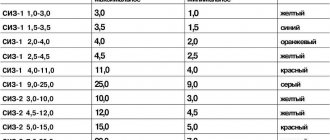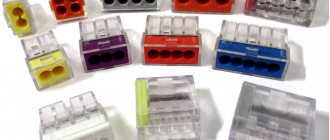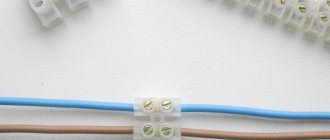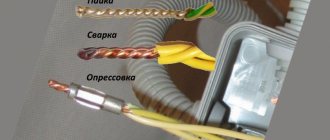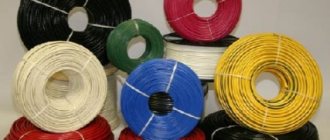When installing electrical wiring, especially in distribution cabinets, it becomes necessary to organize the wiring. Terminal blocks are used for this.
In addition to accuracy and safety, this installation method makes it possible to quickly disconnect the selected line at any time (for example, for repairs), without the need to de-energize the entire system. There are different types of electrical terminal blocks, but certain standards must be followed in their production. The rules for the construction of electrical installations require that GOST 17557–88 “Lighting terminal blocks” be followed. There are other standards, including international ones (ISO, IEC, ITU, SA, CE and others).
Important! When selecting equipment, make sure that you have a manufacturer’s certificate. Information can be requested from the seller (in the technical documentation), or see the markings on the case.
Compliance with standards is necessary not only to comply with PUE standards, your safety depends on it.
Basic requirements for the design of terminal blocks
One way or another, the requirements for reliability and electrical characteristics are specified in various standards.
- Heat resistance is determined by the material of the supporting body. It must be non-flammable. During operation, contact groups can heat up to high temperatures (especially if the contact is poor or the permissible load is exceeded). In this case, there should be no source of combustion.
- When heated, the housing should not change its strength characteristics. If thermal gaps do not ensure retention of contact groups in the mounting sockets, such products cannot be used.
- Protective covers (if any) are not necessarily made of non-combustible materials. However, the material must not support combustion.
- The strength characteristics should ensure that the terminals are fixed under normal force (when the screw clamps are tightened, the plates remain in place).
- Any types of clamps provide reliable fixation of wires without preliminary preparation (tinning, using lugs, forming rings).
- The length of the contact plates prevents contact between the inserted conductors. This is done to counteract galvanic corrosion (eg copper + aluminum).
- The marking should contain information about the diameter of the conductors, the type of current, and the maximum voltage value.
Clearances and creepage distances
Creepage distances are measured along the surface of the insulation between two wires of opposite polarities or between a wire and ground. The minimum creepage distances established by the standards depend, among other things, on the operating voltage of the electrical network, possible network overvoltages and the specific application.
In the case of leakage measured at the surface of an insulator, the characteristics of the insulator used are important since they allow electrical paths to be created more or less easily by forming conductive paths. This occurs due to surface combustion by electrical current, in the presence of water released from plastics, and also due to surface contamination, which causes the remaining carbon atoms to become the same number of points for current to pass through. Therefore, plastics are classified according to this feature.
In English it is called CTI (Comparative Tracking Index), and in French it is called “Indice de Résistance au courant de Cheminement” (IRC). This is the maximum voltage, measured in volts, at which the material can withstand 50 drops of contaminated water without damaging the insulator. Insulator damage (tracking) is defined as the formation of conductive paths due to electrostatic stress, humidity and contamination. The highest class of resistance to surface leakage current (tracking) is class 600V. Therefore, this class allows for the formation of the smallest creepage distance. Ceramic and polyamide PA66 have a CTI class of 600.
Types of terminal blocks according to housing material
At a minimum, the supporting part is made of dielectric. Based on its characteristics, the manufacturer selects the minimum permissible distances between the terminals to prevent air breakdown.
- Ceramics. This material has a lot of advantages, and, perhaps, one drawback: it is fragile. The ceramic terminal block is used in electrical installations with intense temperature conditions: heating devices, powerful power busbars (natural heating of the conductor is allowed). In addition, ceramics are used when organizing wiring near mechanisms that have a high operating temperature. The only limitation is that there should be no vibration or shock loads in the places where ceramic terminal blocks are installed.
- Polypropylene. Durable, relatively plastic material. It resists shock loads and vibration well and does not crack when deformed. However, its temperature and dielectric characteristics do not allow use in high-voltage networks with neutral and phase wires located nearby. Therefore, polypropylene products are usually used on one line (either zero or phase), and are limited to 600 volts.
Another application is terminals for connecting household lighting devices. In such blocks, zero and phase can coexist.
- Polyamide. Durable, non-flammable material with excellent characteristics. At the same time relatively expensive. Used in pads that have high performance requirements. Due to its resistance to external influences, polyamide can be used both in load-bearing elements and in the manufacture of a durable outer casing.
- Carbolite. Perhaps the best non-flammability characteristics, and the dielectric of this material is good. Withstands static loads and vibration, but may crack upon impact. Carbolite terminal blocks are used in any electrical installations, except for heating elements. Except that the cases they make are not very durable.
Carbolite blocks are widely used in household lighting equipment. Almost every second chandelier is connected using such a switch.
- Polyvinyl chloride (PVC). Blocks for mass use for low-current connections. Again, household appliances and lighting. The material is non-flammable, quite durable, but deforms when heated.
The main advantage is the low price. For this reason, many unscrupulous electricians use these blocks for other purposes when assembling powerful electrical installations. Such “savings” often lead to breakdowns of switchboards and electrical equipment failures. In addition, such pads are available in a convenient form factor: the line can be easily divided into the required number of contacts.
- textolite and ebonite are also used . But these are piece products for certain projects: the material is too expensive.
Halogen-free and halogen-free
According to the International Electrochemical Commission (IEC 61249-2-21 Restricted Use of Halogen for Electronic Circuits), for a substance to be classified as halogen-free, it must contain less than 900 ppm of chlorine or bromine or less 1500 ppm halogens.
Halogen elements
is any of the six nonmetallic elements that make up group 17 (group VIIa) of the periodic table. These are fluorine (F), chlorine (Cl), bromine (Br), iodine (I), as well as rare and recently discovered elements astatine (At) and tennessine (Ts). The most common are chlorine and fluorine, found in PVC, Teflon and its derivatives, and bromine, used in plastics as a flame retardant additive. The disadvantage of these products is that they release toxic fumes when ignited. In addition to the risk to people, they also emit corrosive gases that are harmful to electrical and electronic equipment. Among the flame retardants used in plastics, polychlorinated biphenyls (PCBs) and polybrominated biphenyls (PBBs) have adverse effects on the environment and people due to their persistence, toxicity, and bioaccumulation.
When exposed to extreme thermal stresses, which can occur during a fire, brominated flame retardants (BFRs) can form halogenated dioxins and furans.
PBBs and PBDEs (polybrominated diphenyl ethers) are currently banned in Europe by the WEEE (Waste Electrical and Electronic Equipment) and RoHS Directives.
Materials provided by https://ultimheat.com/
Types of terminal blocks according to the method of fastening the conductor
- Screw terminal blocks are available in two form factors: classic plug-in and clamp .
- The classic ones are a screw-nut connection. The contact plate itself acts as a nut. An unprepared conductor is not suitable for such a block: it is necessary to install a terminal at the end, or form a ring. They are mainly used in distribution boxes for wiring indoors.
A more advanced design has a pressure washer-plate under which the unprepared end of the cable can be inserted.
- Clamping blocks are presented in the form of a fixed clamp in which the cable is clamped using a screw:
or in the form of a movable clamp, which is tightened with a screw to the contact pad.
A significant drawback is that the conductor is under pressure and can be deformed (especially for aluminum conductors). As a result, the contact weakens. Such pads need to be tightened at least once a year. Screw connections can also become loose due to vibration.
- Quick-release terminals do not have the disadvantages of a screw connection; the ends of the conductors are attached more securely. The most widely used products are from WAGO; in fact, this is the name given to any pads of this type. Also available in two versions:
- PUSH WIRE (one-piece disposable). When the wire is inserted into the hole, it is clamped. It is impossible to remove it from there: the block will be destroyed.
At the same time, the contact is more reliable than on reusable terminal blocks. They are used after careful checking of the correct cable routing. For possible correction, it is recommended to leave a margin of a few centimeters of wire.
- CAGE CLAMP (reusable). The conductor is clamped using a lever. The advantage is that the contactor can be reused. Disadvantage: the clamping mechanism cannot provide reliable contact.
- Nevertheless, such blocks are quickly gaining popularity, especially among electrician teams involved in connecting apartment buildings.
Types of terminals
Terminal blocks
there are cells in the body
The advantages of such terminal blocks are that different materials can be connected. For example, a terminal connection of aluminum and copper or large cross-section and small. This is very convenient, because the connected aluminum and copper wires oxidize, which causes inconvenience during further operation. Connecting terminals do not allow direct contact of wires with each other. When choosing, you need to know the current that will flow through the wires; it must be less than the rated current of the terminal block. Reliability, of course, is less than with soldering, but it is very convenient, and installation time is also reduced.
According to the design of the connection of wires with a terminal block, there are the following types:
- screw;
- spring;
- knife
Screw terminal blocks
Installing the terminal block does not cause any trouble even for people who are far from electricians. Connecting the wires is very easy: you need to select a block with the required mesh size, insert the wires inside and tighten them with screws. You need to tighten it with a fairly strong force. You need to feel the moment when the screw is already tightened so as not to damage the core. After about a year, it is necessary to check the connection and tighten the screw if necessary. This refers to the disadvantages. There is also no way to connect three wires.
You can also use a rivet instead of a screw. But then you need a special tool, and you need to take into account that the structure is then difficult to disassemble. Place an aluminum wire on the rivet, then a spring washer, a copper wire and a flat washer. This structure is compressed with a special tool. If the same materials are used, then there is no need to place a washer between them. But the last washer should be the same.
Spring terminals
The lever will tighten the wire
The disadvantages include the fact that you have to constantly select the terminal block according to the number of connections. That is, if it is necessary to connect three wires, then you need a terminal block that provides for the connection of three wires. If there are more than six wires, then you will have to combine the terminal blocks with each other. Electrical experts recommend using spring terminal blocks to separate phase and zero
It is also important to remember that if you disconnect the lever once, then the reliability of the connection will deteriorate when clamped again.
Blade terminals
Knife terminals are also easy to use. When connecting, there is no need to pre-clean the contacts. But force must be used, because you need to carefully fix the core in a special knife. Often such terminals are called plug-in terminals and are used in cars, for example, when connecting to a headlight lamp.
Terminals for distribution boxes
Terminal blocks are also used in distribution cabinets. They are presented in the form of a polycarbonate case with a copper platform on which holes for connection are located. They also have steel springs to secure the wires. It is very convenient to use terminal blocks when you need to connect the ground wires into one common one. This type of terminals is suitable for connecting wires of various types. For ease of installation, data with the value of the rated current, wire diameter, and maximum permissible loads are printed on the case. A paste is also provided to prevent overheating.
Fused terminals
Manufacturers have also provided additional protection for the electrical wiring and equip the terminals with a fuse. This type of connection has a holder that holds a standard fuse. Very convenient when operating electrical equipment without a built-in fuse.
Terminal blocks for lighting
Terminal blocks for lighting can significantly simplify and reduce installation when laying electrical equipment for lighting. The case allows you to withstand temperatures of about 105 degrees, copper contacts make it possible to improve conductivity, and springs securely fix the cores. Such terminal blocks are sometimes made with a special paste that protects the connection from oxidation and prevents the conductors from overheating.
Terminals for luminaires
When installing chandeliers, floor lamps or fans together with a chandelier, you can use a terminal block for lamps. It is very convenient to connect up to five wires simultaneously. They are equipped with self-clamping contacts, which facilitates installation and installation, while also reducing the amount of consumables. All terminals are marked and have convenient latches that allow for quick installation.
Types of terminal blocks by contact arrangement
The simplest block is a metal strip with a series of contact clamps. Designed to combine multiple wires with the same rating. For example, zero bus or grounding.
The main wire comes to one of the screw terminals, and the entire block acquires the necessary potential.
The feed-through type is designed for linear connection of wires. Often used for splicing different metals (copper and aluminum).
There is another type of feed-through terminal block.
The main principle is that parallel conductors are separated by a dielectric.
Barrier blocks are similar to pass-through blocks, but they provide more reliable protection against short circuits of adjacent wires. The dielectric extends beyond the contact plane and additionally protects the block from accidental short circuit (for example, a conductive element falling onto the terminals).
Manufacturers
Great importance is given to the manufacturing company. A well-known brand serves as a kind of guarantee of product quality. Therefore, there is no need to save money. Terminals from unscrupulous manufacturers can melt and short out the wiring.
Types of electrical cables and wires: device, purpose, marking and characteristics of the main types of cables used in houses and apartments (150 photos)Methods for laying cables in trenches: step-by-step instructions for laying and installing power cables in earthen trenches (140 photos)
Types of cable channels and cable boxes: types, sizes and materials of manufacture. 120 photos and videos of cable channel installation
The most popular companies producing terminals are WAGO Kontakttechnik and Phoenix Contact.
In conclusion, we note that such concepts as terminal block and universality are incompatible. Each individual situation requires an individual selection of the terminal block, taking into account electrical and strength parameters. Therefore, before you go shopping for a terminal connection, you need to take care of drawing up a wiring diagram, decide and calculate the required number and type of terminals.
Where can I buy
You can purchase pads as quickly as possible at your nearest specialty store. The optimal option, in terms of price-quality ratio, remains purchasing from the AliExpress online store. Mandatory long waits for parcels from China are a thing of the past, because now many goods are in intermediate warehouses in destination countries: for example, when ordering, you can select the “Delivery from the Russian Federation” option:
| UKK 80A Din Rail Terminal Blocks | Din rail with terminal block 10 pcs. | DIN rail terminal block |
| 10pcs Black Din Rail Terminal Blocks | Terminal blocks for din rail PT-2.5 | 30/50/100 pcs. push terminal block |
RoHS and REACH
RoHS (Restriction of Hazardous Substances Directive): The materials used in the connection blocks comply with EU Directive 2015/863, Annex II as amended by Directive 2011/65.
Certificates issued by an accredited independent laboratory are available upon request.
REACH (EU technical regulation "Procedure for state registration, examination and licensing of chemical substances"): the materials used in the connection blocks comply with the EU REACH Directives, according to the Directive of June 2022, adding 173 substances SVHC (Very Highly Hazardous Substances) to the list, published by ECHA on 12 January 2022, applicable under REACH Directive 1907/2006. Certificates issued by an accredited independent laboratory are available upon request.
Application of connectors for stranded wires
If they are still intact, you need to use a special accessory that will protect the veins from destruction. This accessory is a ferrule sleeve. It consists of a metal sleeve and a plastic cuff. For ease of marking, the cuffs are made in different colors. Ideally, with a slight interference fit:
After putting it on the wire, the insulation should rest against the cuff, and the veins should protrude about one millimeter beyond the edge of the sleeve. Correct placement on the conductor is followed by flattening the sleeve using pliers or press pliers. Then you can select a block or terminal block for the tip.
To avoid problems when installing wires and cables when using not only such blocks, but also other detachable connectors, we recommend choosing products from such companies as:
Expert opinion
It-Technology, Electrical power and electronics specialist
Ask questions to the “Specialist for modernization of energy generation systems”
Vago products However, if the selection of equipment and its installation is carried out by a competent specialist, then its durable and uninterrupted operation is guaranteed. Ask, I'm in touch!

